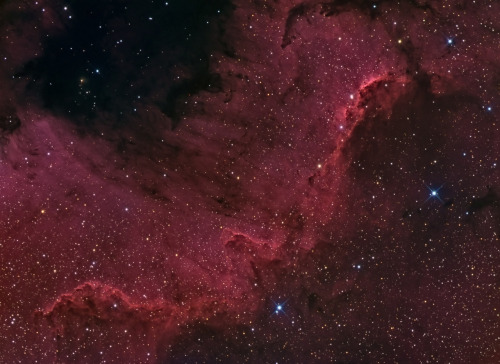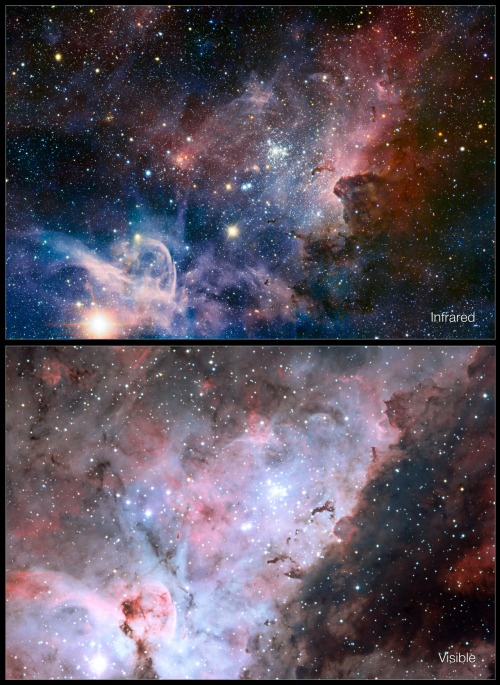This Beautiful Supernova Remnant Is The Product Of A Huge Stellar Explosion In Our Neighboring Galaxy

This beautiful supernova remnant is the product of a huge stellar explosion in our neighboring galaxy — the Small Magellanic Cloud (📷 : NASA)
More Posts from Littlecadet-biguniverse and Others

a night with the stars will usually help
By: Jonah Reenders

NGC 3576, an emission nebula in the constellation of Carina 6,000 light years away. -image via paulhaese.net

Southern NGC7000
js

Night Sky Over Mt. Fuji - Jan. 2016
js

Infrared/visible-light comparison of the Carina Nebula
js

The California Nebula.


Jupiter’s North Pole Unlike Anything Encountered in Solar System
NASA’s Juno spacecraft has sent back the first-ever images of Jupiter’s north pole, taken during the spacecraft’s first flyby of the planet with its instruments switched on. The images show storm systems and weather activity unlike anything previously seen on any of our solar system’s gas-giant planets. “First glimpse of Jupiter’s north pole, and it looks like nothing we have seen or imagined before,” said Scott Bolton, principal investigator of Juno from the Southwest Research Institute in San Antonio. “It’s bluer in color up there than other parts of the planet, and there are a lot of storms. There is no sign of the latitudinal bands or zone and belts that we are used to – this image is hardly recognizable as Jupiter. We’re seeing signs that the clouds have shadows, possibly indicating that the clouds are at a higher altitude than other features.”
Credit: NASA/JPL-Caltech/SwRI/MSSS

The Soul Nebula.

“Rho Ophiuchi Cloud Complex Area Of The Milky Way” by Martin Campbell on Flickr.

Orion Nebula from HAWK-1 js
-
 neph-le-geek reblogged this · 3 years ago
neph-le-geek reblogged this · 3 years ago -
 luminousbeingsarewe reblogged this · 6 years ago
luminousbeingsarewe reblogged this · 6 years ago -
 eswat2 liked this · 8 years ago
eswat2 liked this · 8 years ago -
 lonelyheartsmember reblogged this · 8 years ago
lonelyheartsmember reblogged this · 8 years ago -
 bayonet75 liked this · 8 years ago
bayonet75 liked this · 8 years ago -
 simply-natalie reblogged this · 8 years ago
simply-natalie reblogged this · 8 years ago -
 yikeslukey-blog reblogged this · 8 years ago
yikeslukey-blog reblogged this · 8 years ago -
 bedroomwarfare reblogged this · 8 years ago
bedroomwarfare reblogged this · 8 years ago -
 shoulderkisses reblogged this · 8 years ago
shoulderkisses reblogged this · 8 years ago -
 smolglitterboy-blog liked this · 8 years ago
smolglitterboy-blog liked this · 8 years ago -
 itzmoth liked this · 8 years ago
itzmoth liked this · 8 years ago -
 chewyteea reblogged this · 8 years ago
chewyteea reblogged this · 8 years ago -
 chapparitos reblogged this · 8 years ago
chapparitos reblogged this · 8 years ago -
 hetare-no-ayane liked this · 8 years ago
hetare-no-ayane liked this · 8 years ago -
 thenakedpostmen reblogged this · 8 years ago
thenakedpostmen reblogged this · 8 years ago -
 unatelier reblogged this · 8 years ago
unatelier reblogged this · 8 years ago -
 insomnyakat liked this · 8 years ago
insomnyakat liked this · 8 years ago -
 mlm-after-dark reblogged this · 8 years ago
mlm-after-dark reblogged this · 8 years ago -
 foilflingza liked this · 8 years ago
foilflingza liked this · 8 years ago -
 flufflecat liked this · 8 years ago
flufflecat liked this · 8 years ago -
 lillieofthevalleyofthenile liked this · 8 years ago
lillieofthevalleyofthenile liked this · 8 years ago -
 xsunnyeclipse liked this · 8 years ago
xsunnyeclipse liked this · 8 years ago -
 discovering-gravity reblogged this · 8 years ago
discovering-gravity reblogged this · 8 years ago -
 shetillstheearth reblogged this · 8 years ago
shetillstheearth reblogged this · 8 years ago -
 genrextfln liked this · 8 years ago
genrextfln liked this · 8 years ago -
 itzelvega-blog1 liked this · 8 years ago
itzelvega-blog1 liked this · 8 years ago -
 frog-sensei reblogged this · 8 years ago
frog-sensei reblogged this · 8 years ago -
 elles-sappellent reblogged this · 8 years ago
elles-sappellent reblogged this · 8 years ago -
 panduhs reblogged this · 8 years ago
panduhs reblogged this · 8 years ago -
 southkore liked this · 8 years ago
southkore liked this · 8 years ago -
 alleyneon reblogged this · 8 years ago
alleyneon reblogged this · 8 years ago -
 katecafu-blog reblogged this · 8 years ago
katecafu-blog reblogged this · 8 years ago -
 mekishiba reblogged this · 8 years ago
mekishiba reblogged this · 8 years ago -
 sushigrade reblogged this · 8 years ago
sushigrade reblogged this · 8 years ago -
 realworldswithinthemind reblogged this · 8 years ago
realworldswithinthemind reblogged this · 8 years ago -
 realworldswithinthemind liked this · 8 years ago
realworldswithinthemind liked this · 8 years ago -
 timeisdoomed reblogged this · 8 years ago
timeisdoomed reblogged this · 8 years ago
GREETINGS FROM EARTH! Welcome to my space blog! Let's explore the stars together!!!
144 posts